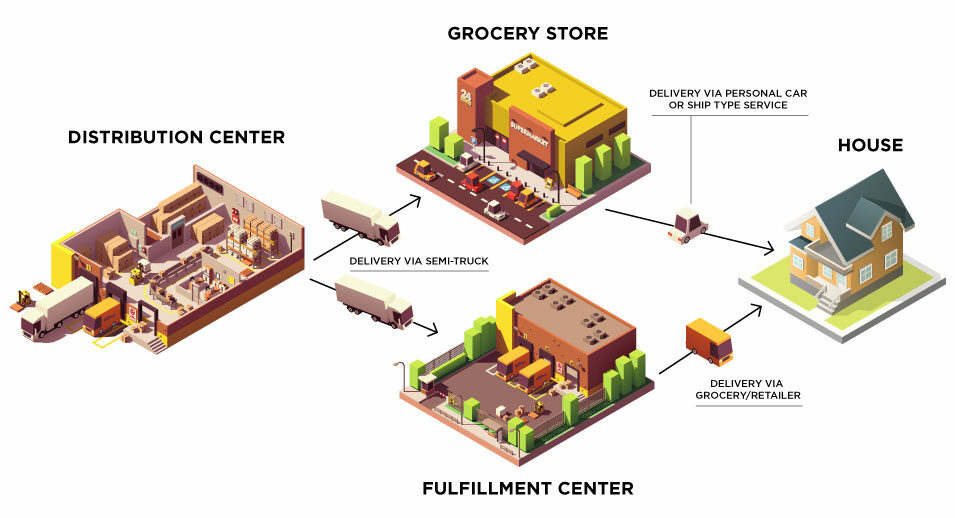Henderson Engineers has decades of experience designing refrigeration systems across grocery, retail, and warehouse environments, so we have our finger on the pulse of how the cold storage market is shifting to accommodate the latest trends. While the COVID-19 pandemic contributed to the pervasiveness of online grocery shopping, the cold storage landscape was already rapidly evolving as consumer behaviors and the push toward sustainability were driving a need for change.
CONSUMER BEHAVIORS
Pre-pandemic, the grocery category was no exception to the continued shift from in-store to e-commerce shopping. As consumers became accustomed to the convenience of online ordering, their expectations were solidified for same-day or next-day shipping and delivery. Additionally, health-conscious consumers had been steadily driving demand for the supply of fresh and frozen foods, meaning suppliers needed to adapt with more – and more functional – refrigeration space. When the pandemic hit, initial panic buying as well as the population of consumers who shifted to online grocery ordering for fear of contracting the virus in stores stressed the distribution chain. Together this surged online grocery shopping by 133% in 2020. A study by grocery e-commerce specialist Mercatus and research firm Incisiv determined online grocery retail growth is expected to make up 21.5% of all grocery sales by 2025 – that’s more than a 60% increase compared to pre-pandemic projections.
SUSTAINABILITY
While sustainability efforts were already underway pre-COVID, the pandemic accelerated the need for energy-efficient cold storage design – especially considering the average facility is between 37 to 42 years old. Various studies estimate that 40% of all food requires refrigeration. Worldwide, 15% of electricity consumed is used for refrigeration equipment. In U.S. supermarkets specifically, refrigeration equipment uses 35-50% of that building’s total energy. Currently, 72% of food retailers have quantifiable goals to reduce energy usage. Demonstrating a commitment to meeting specific sustainability targets with specific, measurable goals is valuable for companies from both a cost savings and branding perspective, and is driving sustainable design more than ever before.
The effects from synthetic refrigerants are also a concern, so we’re seeing more companies make the switch to natural refrigerants like carbon dioxide, propane, or ammonia. In the 1980s, refrigerants that had been used for the previous century were discovered to be depleting the ozone, so phase-out requirements were implemented throughout the next several decades. However, refrigerants that replaced the ozone-depleting substances in the ‘80s have recently been determined to be contributing to climate change as greenhouse gasses. As a result, there’s yet another migration away from the current refrigerants on a global scale.
In the U.S., legislation has been enacted to reduce hydrofluorocarbons (HFCs) – man-made compounds primarily used for air conditioning and refrigeration – for a while now, most recently in the 2020 COVID relief bill. And the U.S. Environmental Protection Agency has reduced the acceptable refrigerant leak rate for commercial refrigeration systems from 35% to 20% on an annual basis. A recent study indicated the average annual leak rate of supermarket/grocery systems to be well above that threshold. This is especially concerning because every pound of traditional refrigerant leaked does 4000x more damage to the environment than a pound of CO2 (the reference refrigerant all others are compared to with regard to GWP). Additionally, leaky systems have poorer performance, which consumes even more energy.
CHANGES IN FULFILLMENT CHAIN
In addition to sustainability and regulatory changes, the cold chain itself is evolving based on consumer and industry needs. The traditional model for grocery supply includes transportation from distribution centers to grocery stores, where consumers purchase goods in person and take them home. But as consumer habits continue to evolve, how do we meet their needs and expectations to get fresh groceries quickly, and in the manner they want?
One way to do this is the addition of fulfillment centers. Fulfillment and distribution are two distinct but related segments in the supply chain. Distribution involves the movement of goods at the pallet or case level to individual stores. Fulfillment deals with moving the individual items to the end user. In the fulfillment center model, food is delivered from production to processing facilities to distribution centers, and then to fulfillment centers which then handle shipping or delivering to the customer. Regardless of shopping method, customers still expect a fresh product. Cold chain supply must be efficient to move perishable product without compromising safety, while also meeting expectations of a speedy delivery.

Henderson has worked with clients on many different parts of the cold chain including traditional grocery stores, curbside and online grocery pickup, remodels, micro-fulfillment centers, last-mile delivery fulfillment centers, and large distribution centers. Here are a few other trends we’re seeing in addition to fulfillment centers.
Henderson’s Principal and Lead Program Manager Jen Jewers Bowlin and Refrigeration Technical Director Dustin Padget discussed trends in sustainable cold storage design in a recent webinar. Watch now to learn more and reach out with questions on how Henderson can guide your cold storage project.
Join our email list to get the latest design innovations, technical content, new projects, and research from Henderson’s experts delivered straight to your inbox.